Review
Mora Bushcraft Survival Knife
By John Fenna
Mora Knives are renowned for being excellent cutting tools at a reasonable price, delivering quality without costing a fortune and therefore proving the ideal introductory-level knife for many a bushcraft as well as still being the favourite cutting tool of some of the iconic figures in bushcrafting circles.
 Recently, Mora have been turning out some very “contemporary” looking knives, restyling old favourites and adding several new models to the range.
Recently, Mora have been turning out some very “contemporary” looking knives, restyling old favourites and adding several new models to the range.
One such new model is the “Mora Bushcraft Survival Knife” which comes with a sheath that has both a Morakniv firesteel and a diamond sharpener mounted on the front of the sheath, and a choice of swappable belt mounting systems.
Before I received a sample of the Bushcraft Survival Knife I was highly sceptical of the practicality of this new addition to the Mora Range. Compared to the Mora “Clipper” the price seemed high, the design seemed a bit gimmicky and I had heard of some quality issues relating to early examples of the sheath.
I was therefore very keen to get some tough testing done when Lurch sent me down a sample to play with!
As I think most people will compare the Mora Bushcraft Survival Knife to the Mora Clipper/Companion, this is what I have also been doing, so to start, here are the basic figures etc on both.
Mora Companion
Steel: carbon or Sandvik 12c27 stainless
Blade Dimensions: 10cm long, 2cm wide, 2mm thick
Grind: Scandi
Handle: plastic moulded onto ¾ tang with a black soft and grippy rubber covering over all but the bolster and butt. Curved ergonomic shape.
Sheath: plastic moulded item with integral belt clip and button hanger. Good friction fit.
Weight: approx 75g (with sheath 100g)
Mora Bushcraft Survival
Steel: Sandvik 12c27 stainless only
Blade Dimensions: 10.8cm long, 2.4cm wide, 2.5mm thick
Grind: Scandi
Handle: plastic moulded onto ¾ tang with a soft black and grippy rubber covering over all the handle. The plastic is only visible right at the end of the butt and a thin portion by the blade. Curved ergonomic shaping with finger choil.
Sheath: a plastic moulded item with 2 interchangeable belt loop units – clip and button type like the Companion, and a solid loop. On the front of the sheath a diamond sharpener is moulded into the plastic, as is a cunning “firesteel” holder. The firesteel is securely held and the knife is held in the sheath even more securely than the Companion.
Weight: 100g (with sheath 200g)
 Now for some more details on the Bushcraft Survival Knife and some “user feedback”.
Now for some more details on the Bushcraft Survival Knife and some “user feedback”.
The Bushcraft Survival Knife comes superbly sharp straight out of the box and has a more massive heft to it than the Clipper, filling the hand nicely for a comfortable grip. I am personally not a big fan of finger choils on knife handles, but I was pleasantly surprised by how comfortable and versatile the handle shaping proved to be over a range of usage and grips employed.
The full rubber handle covering has grip lines moulded in for extra grip – although the rubber alone offers lots of grip – at the “spine” for the thumb and at the butt for extra grip when using an extended grip, i.e. when slashing through twigs etc.
The handle is longer, as well as bulkier, than the handle on the Companion, which should please those with bigger hands.
The blade is basically a beefed up version of the Companion’s blade – bigger in all dimensions, yet retaining the classic Mora shaping and performance.
The Bushcraft Survival proved more than adequate for all the jobs I used it for – from batoning firewood (I do not normally baton much above kindling … but this is called a “survival” knife so I went up to batoning through wood 3” across, both across and along the grain) to feather stick making, carving “woodspirits” and pot hooks to cutting meat and hide. Even chopping carrots proved easy as the 2.5mm blade was not so wide as to “ping” carrot rings across the room! The steel takes, and holds, a superb edge and is not hard to re-sharpen as needed.
Unlike the Companion, the blade of which has a raw spine or back edge, the Bushcraft Survival has a spine that is squared to give the ideal edge for producing sparks from a spark-stick or firesteel as they are also known. This square edge can prove hard on your thumb during “thumb assisted” cuts unless you have work-hardened digits, but is more useful (for sparking the firesteel, and acting as a scraper etc) than it proved a drawback … and you develop callouses if you often use a thumb assist cut!
As a general working tool, the Bushcraft Survival Knife feel meatier than the Clipper or Companion (and, as I understand, is more akin to the Mora Bushcraft Force model) and certainly seems to cope well with tasks I would prefer not to use a Clipper for. This is not to say that I have ever broken a Clipper (or Companion), just that the Bushcraft Survival inspires more confidence to cope with tough usage by dint of its extra dimensions and build!
I certainly found the Bushcraft Survival Knife comfortable and versatile, as well as plenty strong enough for lasting through some demanding testing, yet controllable enough to handle delicate carving as well. A great knife for all bushcrafty type usage is my opinion.
 The sheath of the Mora Bushcraft Survival Knife is – as far as I know – unique in its collection of features and these are where the early models proved to have most problems.
The sheath of the Mora Bushcraft Survival Knife is – as far as I know – unique in its collection of features and these are where the early models proved to have most problems.
The diamond sharpener and firesteel are held in a contrast-coloured plastic unit, which is attached to the moulded plastic body of the sheath, and I had heard reports of the contrast section coming adrift from the sheath. I tried hard to prise this unit off the sheath of the review sample – and achieved nothing more than a couple of scratches in the plastic. Equally, I failed to prise the diamond sharpener out of its home.
The firesteel fits into its holders well, the plastic half loops gripping the shaft of the firesteel securely and the plastic handle of the firesteel clipping under a lip of plastic to stop it rising upwards. The firesteel handle incorporates a lanyard hole for extra security once the shaft of the firesteel wears down to the point that the half loops do not offer a tight grip.
The body of the sheath incorporates a drain hole (for obvious usage) and some thumb grip ridges to help you draw the knife from the sheath. However, I found the friction grip the sheath exerted on the knife was so good and secure that I really needed to push against the rim of the sheath to exert enough pressure to draw the knife. This answered my questions about security raised by some reports of knife falling out of the sheath in use.
I had heard reports of failure involving the exchangeable belt loop feature on early models – so I attacked with vigour trying to deliberately induce failure. And failed!
Although I see this feature as a bit of a gimmick, it seems to work well enough, though I am still inclined to back up my choice of fittings with a paracord linkage. The alternative belt-loops fit with a simple “push and rotate” action which has a spring lock of plastic to avoid accidental detaching of the sheath from belt clip/button hanger or solid belt loop options.
In all, the sheath seems robust, secure and fully functional, with that extra choice of belt loop/clip and the useful features of diamond sharpener and firesteeel.
The diamond sharpener is directly moulded into the front of the contrast-colour unit of the sheath and is as secure as you can get. It measures some 5cm x 2cm and is straightforward to use. The grade of the diamonds is quite course and I would only be tempted to use the sharpener to remove chips and dings or as a first stage in fully re-sharpening a seriously blunted edge.
The firesteel is however one of the best I have used, sending a veritable shower of sparks – not only plentiful but also long lasting – cascading onto the tinder with one stroke of the squared back of the knife. The composition of the firesteel is a bit softer than some spark-sticks I have used so it may not last as long, but the ease of firelighting, thanks to the great sparks, makes up for this in my opinion
 If Mora ever sell these firesteels separately, then I will be buying up several for general use with other knives!
If Mora ever sell these firesteels separately, then I will be buying up several for general use with other knives!
The sparks burn at 3,000 degrees C and the firesteel should give up to 7,000 usages.
Overall, I have found the new Mora Bushcraft Survival Knife a great knife to use for a wide range of tasks. It has proved comfortable, versatile and sturdy in use and, given the choice between the Companion and the Bushcraft Survival Knife for the tasks I generally find myself performing with a knife in the woods, I would plump for the Bushcraft Survival.
The actual knife seems identical to the Mora Bushcraft Force Knife, but the sheath, with its firesteel, diamond sharpener and choice of belt loops, is what sets the Bushcraft Survival apart. If you like the idea of these extras – and many do – then their quality should not disappoint. It really does seem that all the early issues with the sheath have been ironed out.
The Mora Bushcraft Survival Knife comes in Black/Grey or in Black with Lime highlights to the handle, and costs around £55. Some may see this as a little expensive for a Mora – the budget performance knife brand – especially when compared to a Companion at around £10 and the Bushcraft Force at around £23, but when you add in the costs and convenience of the belt loop options and the firesteel and diamond sharpener, I would still say that you are getting good value for money.
I would certainly choose the Mora Bushcraft Survival Knife for my bushcraft – and even survival – needs over another well known survival knife being sold hard to bushcrafters, and which also comes with firesteel and sharpener.
For more information on the Mora range of knives, visit www.morakniv.se
My thanks go to Mark of Lakeland Bushcraft (“Lurch” on this site) who not only supplied the review sample, but whose customer service, prompt delivery and excellent prices are legend on this and other fora.
www.lakelandbushcraft.co.uk

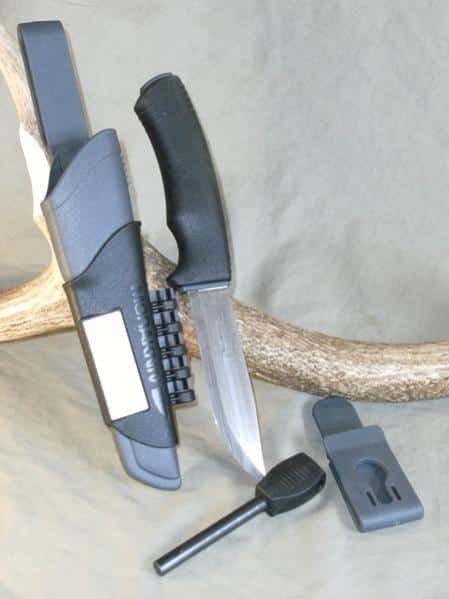
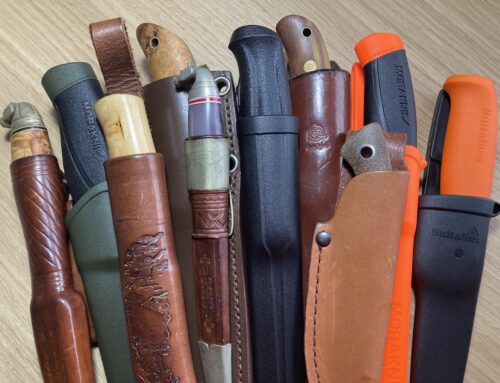
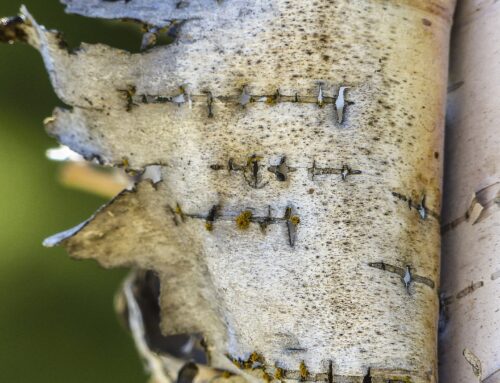
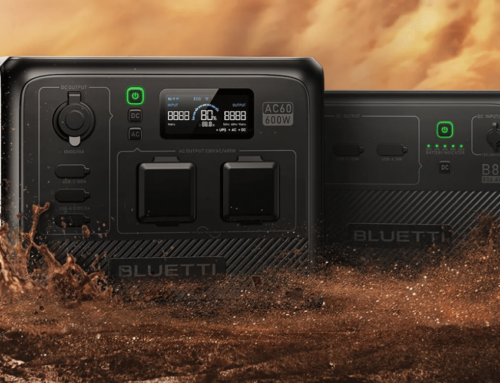
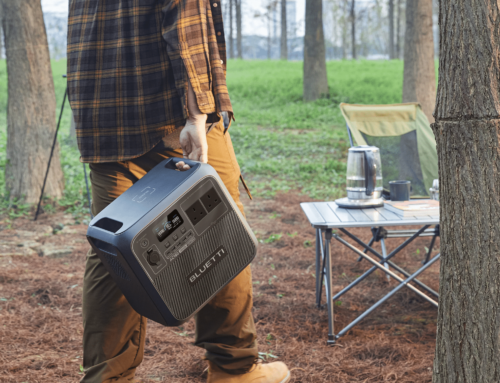
Leave A Comment
You must be logged in to post a comment.